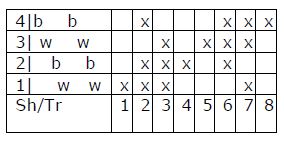It is fast and easy to weave pick-up doubleweave by using the treadles on your loom to separate the ends for the different layers. No extra sticks are needed and nothing has to be moved behind the beater. I first saw this method at Convergence in Denver in 2004 where they were demonstrating three-layered doubleweave but I will explain how to do two layers. A jack- loom and a countermarche loom can both be tied up so that the different sheds can be treadled with just one treadle. The contermarche loom, however, requires eight treadles. With direct tie-up on a jack loom only four treadles are needed since more than one treadle can be pressed at a time. The tie-up is also much faster and easier. I will start by explaining the direct tie-up method.
The warp is made with every other end white and every other end black or other contrasting colors. Thread all the blacks on the even numbered shafts and the whites on the odd numbered shafts. Tie up the shafts directly, i.e. shaft 1 to treadle 1, shaft 2 to treadle 2 etc. Sley the warp with 4 ends per dent in the reed. I used an 8/2 cotton sett at 16 epi per layer(32 epi actual), in an 8 dent reed, but any such combinations can be used. This keeps the four ends, two white and two black, that make up a design-unit in one dent and makes it easier to follow a grid pattern.
During the weaving the shuttle works as a pick-up stick. As you work your way across the warp, the shuttle keeps the ends of the different layers separate as well as pulling the weft across and finishing each shot.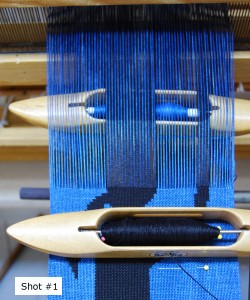
If you want a black figure on a white bottom start by pressing treadle 1 (raising shaft 1) and put your shuttle with white weft into the warp up to the point where the black figure starts. Keep the shuttle in that shed and push treadle 2 and 4 down as well as 1, raising all the black ends. Push the shuttle further into the shed until the end of the black figure, release treadle 2 and 4 and push the shuttle to the end of the warp still pressing treadle 1. Pull the shuttle out and shot # 1 is complete. If there is more than one area of black, repeat the above by pressing treadle 2 and 4 for that area as well.
Now take the shuttle with the black weft and press treadle 1, 2 and 3 (both white and one black) and insert the shuttle up to the beginning of the black figure. Keeping the shuttle in the shed, release 1 and 3, keeping 2 down, push the shuttle through the black area and again press treadle 1 and 3, as well as 2 when the white starts. Pull the shuttle through and shot #2 is completed.
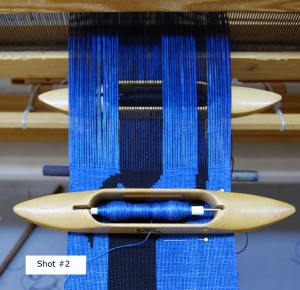
For shot # 3, the white shuttle press treadle 3, insert the shuttle until the black figure starts, press 2 and 4 as well, release them at the end of the black and keep 3 down to finish the shot.
For shot #4, black shuttle, press 1, 3 and 4, release 1 and 3 for the figure and press them down again for the white area.
This completes one unit of design, one square on a graph-paper. Be careful with the joint between the black and white areas by keeping track of which ends belong to which unit. This can always be checked by going up to the reed and to see where each end belongs since the four ends are sleyed in the same dent. Also keep in mind the order that the warp is threaded. If the first end is white, then the last thread in a unit is black.
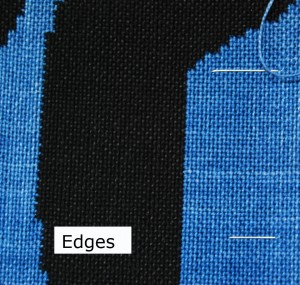
The treadling for a white figure on a black ground is:
- Black weft: For the ground, treadle 2. For the figure treadles 1, 2 and 3.
- White weft: For the ground, treadle 1, 2 and 4. For the figure treadle 1.
- Black weft: For the ground, treadle 4. For the figure treadles 1, 3 and 4.
- White weft: For the ground, treadle 2, 3 and 4. For the figure treadles 3.
To weave treadled double-weave on a contra march loom requires eight treadles even though it is only threaded on four shafts. For each shot two treadles need to be tied up. Shot # 1 alternates between treadle 1 and 2 across the warp, shot #2 alternates on treadle 3 and 4 etc. The advantage is that it is easier to use just two treadles next to each other rather than pressing down up to three at a time. This can also be done on a jack-loom.
Here is the tie-up:
Treadle 2: Shaft 1, 2 and 4
Treadle 3: Shaft 1, 2 and 3
Treadle 4: Shaft 2
Treadle 5: Shaft 3
Treadle 6: Shaft 2, 3 and 4
Treadle 7: Shaft 1, 3 and 4
Treadle 8: Shaft 4
To weave a black figure on a white ground treadle from 1 to 8. To do a white figure on a black ground, treadle the reverse, 8 to 1.
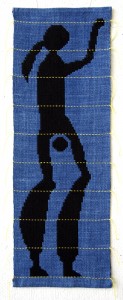
kvinnan

weaving process
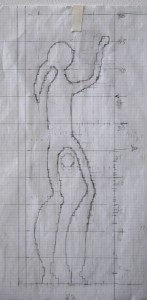
Cartoon
As I was finishing this piece the Fall 2010 issue of the Swedish Väv Magasinet came out. It was a special issue on doubleweave. I scanned the pages for evidence of this method having been used but could not find any mention of it. Western Sweden has a long history of using double weave for blankets and covers and Röhsska Museet in Gothenburg has a large collection. The method mostly used is called Finn-väv (Finnish weaving) where the two colors are threaded two and two rather than every other one as here. The edge between the layers thus changes and become more “toothy” since both shots of white are finished before the two shots of black. That is faster than picking up for every shot but not as fast as the method I have described above.
To see more pictures of Ulla’s work, go to www.ulladelarios.com
The next story will take you to Egypt
